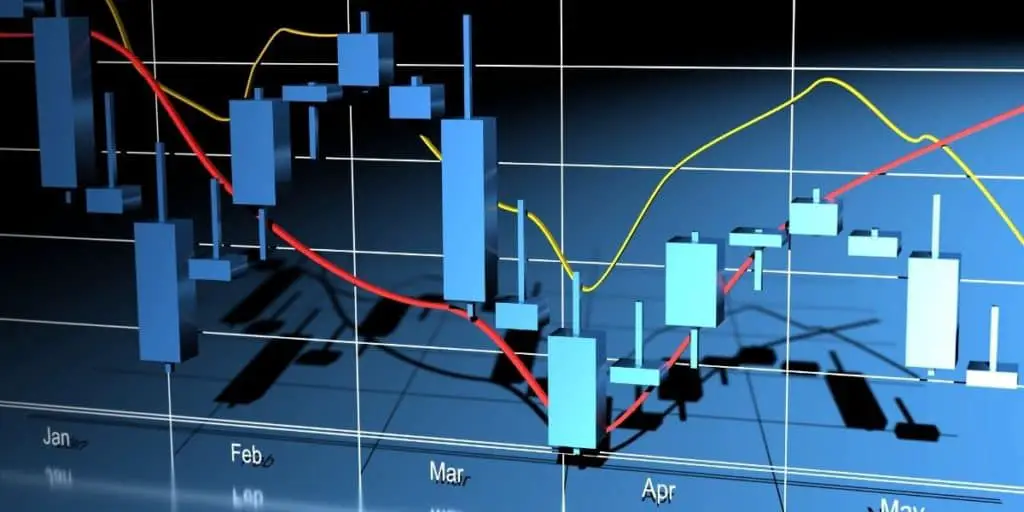Many traders are constantly on the lookout for trading strategies that’ll provide better results. Chart patterns are one of the options widely considered by technical analysts, but are they reliable? Do they work?
Chart patterns work great and are reliable when traded as part of a backtested comprehensive trading strategy that is profitable. Trading success with these patterns also depends on how disciplined a trader, and how skilled is he/she with interpreting and identifying these chart patterns.
This article will cover all you need to know about the efficacy of chart patterns, so you can decide if they’re for you or not.
IMPORTANT SIDENOTE: I surveyed 1500+ traders to understand how social trading impacted their trading outcomes. The results shocked my belief system! Read my latest article: ‘Exploring Social Trading: Community, Profit, and Collaboration’ for my in-depth findings through the data collected from this survey!
Table of Contents
What Are Chart Patterns?
To understand chart patterns, you need to know what a price chart is all about and what it communicates. Whether you’re looking at a candlestick chart or other types of tools, the details printed are a reflection of an asset’s price movement over the given time window.

The price of any asset will move upwards, downwards, or stay sideways in a consolidation pattern. When the market is moving upwards, you’ll see the price going higher across a sequence of swings. It’ll print higher highs and higher lows on your chart.
For a downtrend, the asset price will swing lower, printing lower lows and lower highs. If the price is consolidating in a range, you’ll typically see movement within key support and resistance levels without any real breakout in any direction.
Now, as these movements are printed on a chart, some patterns will gradually start to form.
These are referred to as chart patterns.
Chart pattern traders look at these when making a trade in the hopes that the price action that followed such a pattern in the past will repeat in the future. They use these patterns to enter and exit positions.
Popular Chart Patterns in Trading
There are many chart patterns traders rely on. However, there are a few most of them typically focus on.
The most popular chart patterns in trading include:
- Gaps
- The Spring
- The Pennant
- The Flag
- The Wedge
- The Triangle
- The Head and Shoulders
- The Supernova
- Double Bottom
- The Double Top
- The Rounding Bottom
- The Cup and Handle
Do Chart Patterns Really Work?
One of the biggest tests of efficacy for any trading strategy is how long it’s been in use and the number of traders relying on all or some parts of it. Chart pattern trading has been around for several decades.
Many successful traders owe their success to following a few of these patterns.
There are so many examples on the web, but the story of Dan Zanger is one of the most impressive. He used chart patterns like head and shoulders to turn $10,000 into $18m in just under a couple of years.
Across trading forums, many retail traders are using chart patterns to generate profits from the market. They typically choose a few patterns and create a trading strategy around them.
Why Do Chart Patterns Work?
There are a couple of reasons why chart patterns work.
First, the chart patterns reflect price action at the structural level. This means that traders can get a visual presentation of supply and demand areas for any asset. By looking at the patterns, traders can see when the market hits a top or bottoms out. They can also get at a glance when there’s a lot of volume pushing the markets in a specific direction.
Second, chart patterns are a popular method of technical analysis. This means that millions of traders worldwide are processing the same information, with most of them coming to the same conclusions. This leads to a kind of self-fulfilling prophecy where the market responds to the actions of many traders.
Are Chart Patterns Reliable?
The reliability of chart patterns is subjective.
Two traders working with the same patterns may end up with completely different results overall. However, if you have a solid strategy built around a few chart patterns, you can trust it to deliver similar results to what you saw in your backtests on average.
Chart patterns are about as reliable as all other trading strategies you can think about.
You won’t get 100% accuracy, but if you create a strategy around these patterns that is right 60% of the time and yields at least two times your risk as profits on positive entries, you should close most trading years in profit.
Factors That Affect the Reliability of Chart Patterns
Some of the factors that can affect the reliability of chart patterns include:
The Efficacy of the Strategy
Knowing how to identify all the chart patterns in trading isn’t enough. You need to blend that knowledge into an effective trading strategy.
In reality, you only really need to know a handful of patterns. The best chart pattern traders only learn 2-5 of the best patterns and create a trading strategy around them. The strategy should cover the entry and exit parameters as well as the approach to risk management.
With the main aspects of a strategy secured, running a backtest is the next step to confirm that the strategy works. Many people fail to do a thorough job at this stage because chart patterns aren’t always easy to transform into code for automated tests. However, a proper backtest is the only way to know if your strategy has an edge or not.
Using an untested strategy may yield results in the short term, but you won’t have an idea of what to expect in bad trading weeks, months or years.
The Market Conditions
The best traders know how to account for volatility and market conditions when trading.
A chart pattern formed when the market is within the normal volume range for the asset is more reliable than one formed when volatility is at extremes. Strong volatility can lead to quick invalidation of setups, while low volatility can lure you into a static market where you’ll lose trading costs over time.
The Trader’s Discipline
When you’ve secured an excellent strategy, your success with it will come down to your discipline in execution. You need to stick to your trading rules.
Enter positions when the strategy dictates, using the right risk management metrics. Exit at the appropriate time as well. Don’t enter or close trades with your gut feeling, as this can end up distorting your trading results overall.
Should You Trade With Only Chart Patterns?
As we mentioned above, trading with chart patterns is similar to using other technical analysis approaches. Just as you can’t take trades without confirmation on other strategies, you need to confirm all your entries when using chart patterns to make decisions.

Jumping into positions as soon as you spot a pattern will deliver a very low level of accuracy. The best chart patterns are those supported by other triggers. For example, a signal formed just off a supply or demand zone has a higher chance of success than one formed in the middle of a trend.
As you work on a strategy based on chart patterns, you need to include methods of confirmation. You may also choose to combine the chart patterns with another strategy. However, be sure to avoid analysis paralysis, which comes with including too many confirmatory steps.
Author’s Recommendations: Top Trading and Investment Resources To Consider
Before concluding this article, I wanted to share few trading and investment resources that I have vetted, with the help of 50+ consistently profitable traders, for you. I am confident that you will greatly benefit in your trading journey by considering one or more of these resources.
- Roadmap to Becoming a Consistently Profitable Trader: I surveyed 5000+ traders (and interviewed 50+ profitable traders) to create the best possible step by step trading guide for you. Read my article: ‘7 Proven Steps To Profitable Trading’ to learn about my findings from surveying 5000+ traders, and to learn how these learnings can be leveraged to your advantage.
- Best Broker For Trading Success: I reviewed 15+ brokers and discussed my findings with 50+ consistently profitable traders. Post all that assessment, the best all round broker that our collective minds picked was M1 Finance. If you are looking to open a brokerage account, choose M1 Finance. You just cannot go wrong with it! Click Here To Sign Up for M1 Finance Today!
- Best Trading Courses You Can Take For Free (or at extremely low cost): I reviewed 30+ trading courses to recommend you the best resource, and found Trading Strategies in Emerging Markets Specialization on Coursera to beat every other course on the market. Plus, if you complete this course within 7 days, it will cost you nothing and will be absolutely free! Click Here To Sign Up Today! (If you don’t find this course valuable, you can cancel anytime within the 7 days trial period and pay nothing.)
- Best Passive Investment Platform For Exponential (Potentially) Returns: By enabling passive investments into a Bitcoin ETF, Acorns gives you the best opportunity to make exponential returns on your passive investments. Plus, Acorns is currently offering a $15 bonus for simply singing up to their platform – so that is one opportunity you don’t want to miss! (assuming you are interested in this platform). Click Here To Get $15 Bonus By Signing Up For Acorns Today! (It will take you less than 5 mins to sign up, and it is totally worth it.)
Conclusion
Chart patterns are useful signals for entering and exiting the markets. Millions of traders worldwide trust them in some capacity, which is a sign that they work. They’re also as reliable as other excellent technical analysis methods, with results largely dependent on application.
Before trading with chart patterns, be sure to create a sound strategy backtested properly to ensure a statistical edge. A solid strategy based on chart patterns can deliver excellent trading results, as many traders have demonstrated over time.
BEFORE YOU GO: Don’t forget to check out my latest article – ‘Exploring Social Trading: Community, Profit, and Collaboration’. I surveyed 1500+ traders to identify the impact social trading can have on your trading performance, and shared all my findings in this article. No matter where you are in your trading journey today, I am confident that you will find this article helpful!
Affiliate Disclosure: We participate in several affiliate programs and may be compensated if you make a purchase using our referral link, at no additional cost to you. You can, however, trust the integrity of our recommendation. Affiliate programs exist even for products that we are not recommending. We only choose to recommend you the products that we actually believe in.
Recent Posts
Exploring Social Trading: Community, Profit, and Collaboration
Have you ever wondered about the potential of social trading? Well, that curiosity led me on a fascinating journey of surveying over 1500 traders. The aim? To understand if being part of a trading...
Ah, wine investment! A tantalizing topic that piques the curiosity of many. A complex, yet alluring world where passions and profits intertwine. But, is it a good idea? In this article, we'll uncork...
